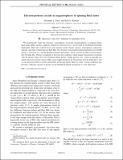Electron-positron cascade in magnetospheres of spinning black holes
Author(s)
Ford, Alexander L.; Keenan, Brett D.; Medvedev, Mikhail V.
DownloadPhysRevD.98.063016.pdf (6.644Mb)
PUBLISHER_POLICY
Publisher Policy
Article is made available in accordance with the publisher's policy and may be subject to US copyright law. Please refer to the publisher's site for terms of use.
Terms of use
Metadata
Show full item recordAbstract
We quantitatively study the stationary, axisymmetric, force-free magnetospheres of spinning (Kerr) black holes (BHs) and the conditions needed for relativistic jets to be powered by the Blandford-Znajek mechanism. These jets could be from active galactic nuclei, blazars, quasars, microquasars, radioactive galaxies, and other systems that host Kerr BHs. The structure of the magnetosphere determines how the BH energy is extracted, e.g., via the Blandford-Znajek mechanism, which converts the BH rotational energy into Poynting flux. The key assumption is the force-free condition, which requires the presence of plasma with the density being above the Goldreich-Julian density. Unlike neutron stars, which in principle can supply electrons from the surface, BHs cannot supply plasma at all. The plasma must be generated in situ via an electron-positron cascade, presumably in the gap region. Here we study varying conditions that provide a sufficient amount of plasma for the Blandford-Znajek mechanism to work effectively.
Date issued
2018-09Department
Massachusetts Institute of Technology. Laboratory for Nuclear ScienceJournal
Physical Review D
Publisher
American Physical Society
Citation
Ford, Alexander L. et al. "Electron-positron cascade in magnetospheres of spinning black holes." Physical Review D 98, 6 (September 2018): 063016 © 2018 American Physical Society
Version: Final published version
ISSN
2470-0010
2470-0029